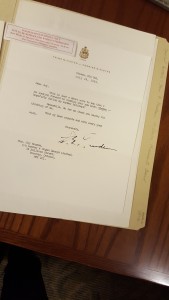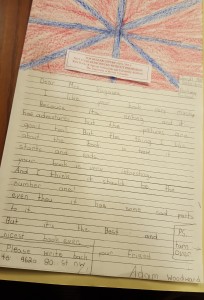Hey guys,
I am back and unfortunately this will be my final blog post for this semester! Since the first post back in September, I have been having a blast posting all of these blogs and really enjoyed this whole weekly blogs concept as you get a chance to express what happened in class.
This week, our class had a special opportunity to head down to the Irvin K. Barber Learning Center to explore the Kogawa fond. I found this little field trip quite fascinating as we all had a chance to explore the inner works of Joy Kogawa’s Obasan. This is something that we should be fortunate about since us UBC students can just casually access during our lunch breaks, while others around the world would have to make a special trip to see the fond. During my time there, there were a lot of things that caught my eye such as: old newspapers, reviews and critics on the novel, funny letters from children about the novel and even a letter from Pierre Trudeau himself saying that he was “looking forward to reading [her] new book, Obasan — hopefully during [his] summer holidays!”.
In a literature class, we are always so focused on the book itself and tend to forget the process and experiences the author faced in making the novel. Our field trip gave us that opportunity by exploring the Kogawa fond which changed our view and focus from the classroom setting which was really refreshing. Also, I would like to emphasize on how lucky our ASTU class was to access the primary sources of the items that revolved around Obasan (newspapers, letters, pictures, etc.) versus the secondary sources that many other people would have been limited to (a copy of the novel). Throughout all of the newspapers, letters and pictures I have read and seen, there was one letter in particular written by Gail Fox that caught my attention. He argued that “This novel, I feel, should be read by every concerned member of Canadian Society”. I find this statement very true as it really hit home since I have lived in British Columbia my entire life and to find out that Japanese-Canadians were forced out of their homes in Vancouver and to be moved into internment camps because they were suspected of being spies is absolutely shocking, especially if they have been living there a majority of their life time. For that reason alone, it would have been enough to make me want to read Obasan. After reading the novel, I must say that I would highly recommend it to anyone who is curious about what happened to the Japanese-Canadians during and after World War Two.
Overall, I had a great time exploring the Kogawa fond and I really hope that we get a chance to head back to the Irving K. Barber Learning Center next semester to explore more collections!
-Martin
Citations
Fox, Gail. Letter from Gail Fox to Joy Kogawa. N.d. Box 12 File 2. Joy Kogawa fonds. University of British Columbia Library Rare Books and Special Collections, Vancouver, Canada.
Trudeau, Pierre. Letter from Pierre Trudeau to Joy Kogawa. 24 July. 1981. Box 58 File 4. Joy Kogawa fonds. University of British Columbia Library Rare Books and Special Collections, Vancouver, Canada

